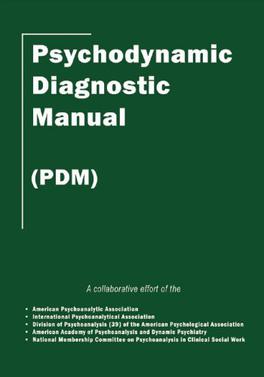Psychodynamic Diagnostic Manual
Psychodynamic Diagnostic Manual
The Psychodynamic Diagnostic Manual (PDM) is a diagnostic framework that aims to provide a comprehensive understanding of an individual's psychological functioning. Developed by the Psychodynamic Diagnostic Manual Task Force, the PDM offers a psychodynamically oriented approach to assessment and diagnosis.
History[edit | edit source]
The PDM was first published in 2011 as a response to the limitations of existing diagnostic systems, such as the Diagnostic and Statistical Manual of Mental Disorders (DSM) and the International Classification of Diseases (ICD). The PDM sought to capture the complexity of human experience and behavior through a psychodynamic lens.
Key Concepts[edit | edit source]
Central to the PDM is the emphasis on understanding the individual in the context of their unique life story, relationships, and internal dynamics. The manual includes a range of diagnostic categories that reflect the diversity of psychological presentations, with a focus on underlying psychological processes and conflicts.
Diagnostic Categories[edit | edit source]
The PDM organizes diagnostic categories into five major domains: Personality Patterns, Psychodynamic Conflict, Defense Mechanisms, Psychological Capacities, and Psychosocial Stressors. Each category is further elaborated to capture the nuances of an individual's psychological functioning.
Assessment Process[edit | edit source]
Clinicians using the PDM engage in a comprehensive assessment process that involves gathering information through interviews, observation, and psychological testing. The goal is to develop a rich understanding of the individual's inner world and external circumstances to inform diagnosis and treatment planning.
Clinical Utility[edit | edit source]
While the PDM is not intended to replace existing diagnostic systems, it offers a valuable complement for clinicians seeking a deeper understanding of their patients. By focusing on psychodynamic principles, the PDM can help clinicians uncover underlying dynamics that may not be captured by traditional diagnostic criteria.
Criticisms[edit | edit source]
Critics of the PDM have raised concerns about its complexity and potential overlap with existing diagnostic systems. Some argue that the psychodynamic approach may be less standardized and more subjective compared to the DSM and ICD, raising questions about reliability and validity.
Future Directions[edit | edit source]
As the field of psychology continues to evolve, the PDM may undergo revisions and updates to reflect current research and clinical practices. Collaborative efforts among clinicians and researchers will be essential in refining the PDM and ensuring its relevance in contemporary mental health care.
Navigation: Wellness - Encyclopedia - Health topics - Disease Index - Drugs - World Directory - Gray's Anatomy - Keto diet - Recipes
Search WikiMD
Ad.Tired of being Overweight? Try W8MD's physician weight loss program.
Semaglutide (Ozempic / Wegovy and Tirzepatide (Mounjaro / Zepbound) available.
Advertise on WikiMD
WikiMD is not a substitute for professional medical advice. See full disclaimer.
Credits:Most images are courtesy of Wikimedia commons, and templates Wikipedia, licensed under CC BY SA or similar.Contributors: Prab R. Tumpati, MD

